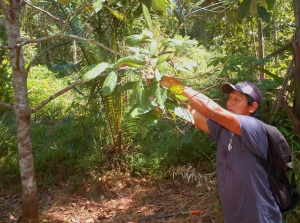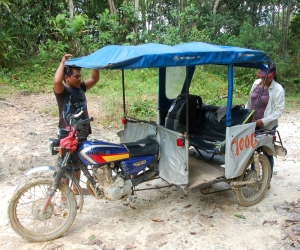
Juan Silvano harvesting rosewood leaves from Miguel’s tree. Photo by Campbell Plowden/CACE
One highlight of my recent trip to Peru was spending a day with Miguel and Celestina – a couple who live in Tamshiyacu, a small town that is about an hour and a half by Iquitos by speed boat. I first toured their farm a year ago with our local contact Juan who introduced us to a few families that had planted rosewood trees in a community development project around 2003.
They warmly greeted us in their home filled with their children, grandchildren and dogs. Other families in the area had either sold their land or sold the rights to their rosewood trees to a new company making essential oil. I was pleased that this senior citizen couple wanted to work with us to manage the rosewood trees they had left on their property.

Motorcar from Tamshiyacu. Photo by Campbell Plowden/CACE
Heading out with machete and large collecting basket, our project manager Yully, Celestina and I sat in the back seat of a motorcar while Miguel and CACE videographer Tulio perched in the luggage rack in back. We soon got beyond the paved road in town and traveled for miles on dirt roads that were rutted but solid since the “dry” season rains were not intense. Twenty minutes out, we passed by some rough wooden buildings with tarp roofs in a clearing made by roughly hacking down a section of rainforest. The government was creating these new settlements by giving land rights to poor families seeking a place to farm.

Miguel squeezing sugar cane with wooden press. Photo by Campbell Plowden/CACE
The motorcar dropped us off at a tiny trail entering the woods on the other side of the road and promised to pick us up at the end of the day if we could reach him on his cell phone. After a half-hour hike, we reached Miguel and Celestina’s plot that they had legally acquired over twenty years ago. They had planted yucca (also known as cassava and manioc) as their main staple food. Pineapples, umari fruit, and Brazil nuts were their main commercial crops. Sugar cane provided snack food. They hoped that selling rosewood material could increase their modest income.

Miguel tagging rosewood tree on his property. Photo by Campbell Plowden/CACE
We got to work tagging and measuring all of the rosewood trees that were still alive a dozen years after the donated seedlings were transplanted into their field. Some were vigorous tall trees that seemed good to maintain as a source of seeds in the future. Many had grown to 30 feet tall and seemed good candidates to be pruned to provide branches and leaves for distilling. A few were still no bigger than seedlings that might grow if exposed to more light.

Tulio measuring rosewood tree diameter. Photo by Campbell Plowden/CACE
After four hours of hot hard work, we gathered under their rustic shelter built to protect bags of charcoal they were soon going to sell. Miguel then cut up and gave each of us a whole pineapple to savor – the freshest and sweetest I had ever had in my life.
We promised to return soon to do our first modest harvest to make a small batch of rosewood oil. We will need to undertake this task carefully, though, since many of the trees have grown very large and will need to be pruned carefully to keep them healthy and produce good material for distilling in the future.

Miguel, Celestina, Yully Rojas and Campbell Plowden. Photo by Tulio Davila/CACE
In addition to helping this couple in the coming years, we hope to learn a lot about rosewood tree growth and management that we can apply to our rosewood project at Brillo Nuevo being developed with our partner Camino Verde. Those trees are now almost three years old, and we expect to conduct our first experimental harvest in early 2016.


